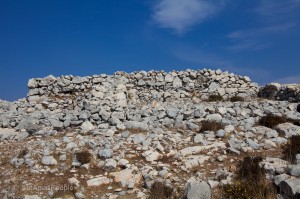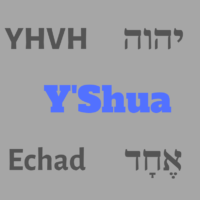Introduction

The Discovery on Mount Ebal
Deuteronomy 27:1–8
1 Then Moses and the elders of Israel charged the people, saying, “Keep all the commandments which I command you today. 2 “So it shall be on the day when you cross the Jordan to the land which YHVH your Elohim gives you, that you shall set up for yourself large stones and coat them with lime 3 and write on them all the words of this law, when you cross over, so that you may enter the land which YHVH your Elohim gives you, a land flowing with milk and honey, as YHVH, the Elohim of your fathers, promised you. 4 “So it shall be when you cross the Jordan, you shall set up on Mount Ebal, these stones, as I am commanding you today, and you shall coat them with lime. 5 “Moreover, you shall build there an altar to YHVH your Elohim, an altar of stones; you shall not wield an iron tool on them. 6 “You shall build the altar of YHVH your Elohim of uncut stones, and you shall offer on it burnt offerings to YHVH your Elohim; 7 and you shall sacrifice peace offerings and eat there, and rejoice before YHVH your Elohim. 8 “You shall write on the stones all the words of this law very distinctly.â€
 Later in the book of Joshua we have recorded that Joshua did as Moses has told him and built the altar and performed the ceremony to pronounce the blessings and the curses as Moses had instructed them.
Joshua 8:30–35
30 Then Joshua built an altar to YHVH, the Elohim of Israel, in Mount Ebal, 31 just as Moses the servant of YHVH had commanded the sons of Israel, as it is written in the book of the law of Moses, an altar of uncut stones on which no man had wielded an iron tool; and they offered burnt offerings on it to YHVH, and sacrificed peace offerings. 32 He wrote there on the stones a copy of the law of Moses, which he had written, in the presence of the sons of Israel. 33 All Israel with their elders and officers and their judges were standing on both sides of the ark before the Levitical priests who carried the ark of the covenant of YHVH, the stranger as well as the native. Half of them stood in front of Mount Gerizim and half of them in front of Mount Ebal, just as Moses the servant of YHVH had given command at first to bless the people of Israel. 34 Then afterward he read all the words of the law, the blessing and the curse, according to all that is written in the book of the law. 35 There was not a word of all that Moses had commanded which Joshua did not read before all the assembly of Israel with the women and the little ones and the strangers who were living among them.
Many teams of archaeologists tried to find this altar but with no success. We see people like the British survey of Colonel Anderson and Charles Wilson doing a survey in February 1866, the French scholar Victor Guerin, who searched for the altar in May 1870 and in 1872, Cluade Regnier Conder and Henry Kitchener of the British Royal Engineer corps all attempting to find this altar on what they believed was the correct position on Mount Ebal. They all concluded that the southern slope of Mount Ebal was not a suitable candidate for Joshua’s altar. The last person to search for the altar was the French priest and scholar Raphael Tonneau, who studied the area in February 1922. He published a French article called “The sacrifice by Joshua on Mount Ebal” in “Revue Biblique” in 1926. He started raising some very interesting questions about the location. This included the statement that it would not be possible to have sound travel to the peaks of Mount Gerizim and Mount Ebal (they are about 4km apart). Mount Ebal is 960m above sea level and Mount Gerizim is 60m lower. He made the suggestion that the location should rather be at the valley floor. The location should be a natural amphitheater to be able to support the ritual of the blessings and the curses.
By this time, the academics had given up on finding the altar, and it became another Bible legend. Then during 1967, after the Six-Day war, the government of Israel initiated an “Emergency Archeological Survey of Judea, Samaria and the Golan.” This was done as the government had assumed that these territories would have to be returned to King Hussein as part of the peace treaty with Jordan. This produced the first archeological and historical map of Samaria and the Golan. This was finally drawn in August and October of 1967. Dr. Zertal was a part of the team that did this initial survey and after 10 years when searching for a topic for his master’s degree, he was again drawn to this area. He first started off by doing a survey of the Dothan Valley in Northern Samaria. It was later discovered that the real name was the Hepher Valley. This survey led them to the internal ridges of the Shechem Syncline with places like the city of Shechem and Mount Ebal.
During February 1980 the team started with a survey of Mount Ebal. After two months of survey work, on Monday 6 April 1980, they stumbled upon a heap of stones on the north end of second terrace from the top. This heap was around 4m high and 30m in diameter. Dr. Zertal also mentiones that he noticed the coarse potsherds of the Israelite settlement period littering the area. He furthermore found a fragment of a bull’s head on the site which indicated that they may have stumbled upon an interesting site. It took another two years before Dr. Zertal returned to the site. By this time, he had started his Ph.D studies and was once again in search of a topic. In the fall of 1982, they raised enough money to make the site accessible for them to start a study of the site. He also chartered a plane and took photographs of the site before starting any work. In October 1982, they found that underneath the uppermost stone layer was a solid rectangular platform (bamah). The top of the platform was paved with undressed stones of intermediate size.
During the next six years, he led six digs to the site that revealed a lot of very interesting material. Until today, the complete site has not been excavated, as is currently the practice. They have left some portions of this site to future generations with better knowledge and techniques to try to learn even more.
Based on his work at Mount Ebal, Dr. Zertal wrote an article in Biblical Archaeological Review titled “Has Joshua’s Altar Been Found on Mt. Ebal? Adam Zertal, BAR 11:01, Jan/Feb 1985.” After this article and the storm it caused, he also published a number of academic papers to describe the evidence they found at the site and why he is convinced of the proof they found. He believes the proof is sufficient to indicate, with a high degree of certainty, that what he found could be the altar that Joshua had built. You can see some of Dr. Zertal’s information on his site at the university of Haifa - http://ebal.haifa.ac.il/ebal06.html
What proof was found at the site?
As already mentioned, the site was strewn with potsherds. These coarse potsherds are brown gray pottery, fortified with crushed stone and well fired. The potsherds from the Israelite settlement period was never painted or decorated. On the day of our trip, we still found a number for these sherds around the altar and even brought a number of these home with us. What was fascinating about this site is that all the sherds found were only from one period. In most settlements, the sherds of several periods are found to indicate when the site was established and when it was abandoned. This indicated that there was never a permanent settlement on this specific site.
This conclusion is further supported by the fact that no proof of permanent dwellings was discovered on the site. The exception being a single building of the same period that was most likely used by the priests. The probability is high that this might have been the place where the priests kept all their equipment they used during their service at this altar. This fact is proof that this mount has been considered “holy” by the people, and therefor no-one was allowed to build any house on the mountain. Moreover, on Mount Zion, to date, no permanent dwellings have been discovered. Thus, we now know that this was a holy site that was created and used in the Israelite settlement period.
The pile of stones that lead to the initial investigation was, in fact, a rectangular structure. It consisted of a central platform, that was filled in the middle and made of walls of stone. Leading up to the platform was a ramp. This is also in line with the commandments that were given regarding the priests not coming to the altar for offerings using stairs. The ramp was wide enough for a person carrying a heavy object to use with relative safety. The north-south axis slices exactly through two opposite corners of the structure. The four points of the compass roughly quartered the site like an “X” marking a treasure.
The filling of the structure included the ash and bones of a number of clean animals. The distribution of the fill suggested that it was not gradually accumulated, but packed quickly inside in an organized manner. The altar of the tabernacle was also a filled box, exactly like this one.
 Exodus 27:1–8
1 “And you shall make the altar of acacia wood, five cubits long and five cubits wide; the altar shall be square, and its height shall be three cubits. 2 “You shall make its horns on its four corners; its horns shall be of one piece with it, and you shall overlay it with bronze. 3 “You shall make its pails for removing its ashes, and its shovels and its basins and its forks and its firepans; you shall make all its utensils of bronze. 4 “You shall make for it a grating of network of bronze, and on the net you shall make four bronze rings at its four corners. 5 “You shall put it beneath, under the ledge of the altar, so that the net will reach halfway up the altar. 6 “You shall make poles for the altar, poles of acacia wood, and overlay them with bronze. 7 “Its poles shall be inserted into the rings, so that the poles shall be on the two sides of the altar when it is carried. 8 “You shall make it hollow with planks; as it was shown to you in the mountain, so they shall make it.
During the further excavations, they found below this central structure another smaller structure built upon the bedrock. This was a round structure of medium-sized stones of two meters in diameter. It too had been filled with ashes mixed with bones. It was obvious that the builders of the bigger structure were aware of this earlier structure. It also became clear to the people, that the pile of stone, which was actually an altar, was deliberately covered.
In front of the platform, they discovered during the second season two cubical stone compartments, which leaned against the ramp. These two compartments contained ashes and scorched animal bones. In the central structure around 1,000 animal bones were found. All these bones belonged to four species: sheep, goats, cattle and fallow deer. At the complete site, a total of 2,862 bones were found and analyzed. What is most fascinating is that none of these bones belonged to any working animals. Furthermore, these bones were of young animals, as would typically be used in sacrifices. This once again confirmed that there had never been a settlement on this site. They did find some bones of rodents (not in the altar), but this is common for most sites that have been unpopulated for so long.

At the site, they also discovered two scarabs. Scarabs originate in ancient Egypt where it was used as a small seal. It resembles a dung-beetle that is either stooping or prostrate. These were widely used throughout the ancient Near-East and were normally worn around the neck or as a ring. Many of these scarabs have been found, and the collection has allowed modern researchers to build an accurate time-line of scarab production. Not all experts accept the method of using scarabs to determine the date of a specific site. The first scarab was found in a heap of grayish stone that was separated from the main structure during an earthquake. This scarab contained some interesting markings that allowed the experts to date it to the time of Ramesses II and specifically during the final third of the 13th century (1230 – 1200 B.C). The second scarab was found much later in the bedrock and must have been brought there around the time of the building of the foundation of the altar. It was dated by an expert Baruch Brandl in Jerusalem. He concluded that this scarab was from the same date as the first. The symbols on the scarab were interpreted to mean “The king who commands many archers.” This was one of the names of Pharaoh Thutmosis III (1504-1450 B.C). The scarab was issued as a memory of the empire’s founder by Ramses II, who saw himself as the successor to Thutmosis. Thus, the date estimation provided by the potsherds was now even more specific.
In a natural recess in the bedrock below the altar another very significant discovery was made. In this cache a stone incense burner, shaped like a chalice, and two stone hammers were found. These objects had been carefully placed and covered with a layer of ash.  The function of the incense burner is known from ritual drawings found in the ancient Near East. Priests used these to make incense offerings. The vessel was made of volcanic foam that cools into a lightweight porous rock. The nearest source of such rock was the Golan Heights or Transjordan. What was very interesting of this specific burner is that a perfect copy of this (only a bit larger) was found in 1906 by Sir Flinders Petrie at the Sarabit complex. This site is located in Western Sinai about 100km southeast of the city of Suez. This site was a mine that the Egyptians used to mine minerals.  The burner was found in a cave that was considered as the “holy of holies” of this site. Similar vessels to this was discovered in Egypt and Mesopotamia. The design is dated to the 19th and 20th Egyptian dynasties – 13th – 12th centuries B.C.  Thus, this burner confirmed that the site was a religious site and dated it again the time-frame determined by the pottery and scarabs.
During the fourth season of excavation, they also discovered around forty small pieces of very thick plaster. The plaster flakes were concentrated in a tiny pit at the bottom of the altar. These pits were normally used to store vessels that had been declared unfit. The analysis of this plaster has not yet been completed. The script that was found on the plaster is of a “proto-Hebraic” script.
The altar itself stands within two enclosures. The outside wall is in a shape like a long triangle, its base facing north and the apex pointing south. The southern point of the triangle is open, and it is possible that this was the original entrance that had been removed by agricultural activity. Inside this enclosure at the base (northern side) is another smaller enclosure. Within this enclosure is the altar complex. When looking at this complete view from the top of mount Ebal, it creates a picture that resembles a very large footprint. The only way to get from the great enclosure into the smaller was via an opening that consisted of three wide stone steps. This counters the theory that these enclosures are simply the walls of a large structure. These stairs were also much wider than the doors of a typical house of this period would have been.
The last topics of the site that I would like to mention are the location and characteristics of the site itself. When looking down at this valley from the top of Mount Ebal, it very soon becomes clear that this valley is large enough to accommodate a sizeable crowd. This was definitely required if you wanted to put the complete nation in one place. If the nation was to be in one place and perform the ceremony required, including the feast (eating of sacrifices) afterwards, there also needed to be a source of water nearby. Just below the altar site the archaeologists have found a water supply. The last but most important point relates back to the observation that was made by Raphael Tonneau in his 1926 article. If all the priests stood in front of the altar and pronounced the curses and the blessings, there had to be a way for all the people to hear them. Thus, this location had to have exceptional acoustics. To demonstrate the acoustics of this site, our tour guide asked the children of the group to run ahead of us in the direction of the altar while the adults remained in the shade of the trees. He instructed them to call towards us. The kids went ahead and ran about 300-400 meters from us in the direction of the altar. Before they could even begin to call, they spoke in normal voice to one another, and it was possible for us to hear every word they were speaking. Dr. Zertal and his team also did some experiments and found that people in the valley could hear someone talking loudly from the top of the altar. From the instructions in the Bible, we know that it was important for every person to be able to hear every word that the priests spoke. From the description in Joshua 8, we know that the priests stood in front of the altar with the ark of the covenant.
The only problem now remaining is to clarify where the people were when all of this was happening. It was stated before that the altar was found on the eastern side of Mount Ebal. We also know from the scriptures that the people were split between Mount Ebal (mount of the curses) and Mount Gerizim (mount of blessings). The problem is that the altar is “behind” Mount Ebal, and it would not be possible for the people to be on Mount Gerizim and hear or see the priests. In order to solve this, we need to make a careful study of what the Hebrew says about where the people were. The first thing we must note is that the altar was not UPON Mount Ebal but AT the mountain (“behar Ebal” in Hebrew). This also defines that the altar is somewhere between the summit (al in Hebrew) and its foot (tahat.) To put the last pieces of the puzzle in place we need to throw away some of the pictures we have in our minds regarding how this was done. A lot of us (myself included) were taught that half the tribes stood on Mount Ebal, and the other half stood on Mount Gerizim. However, please read the following verse from Joshua again very carefully ( I have added highlights):
Joshua 8:33
33All Israel with their elders and officers and their judges were standing on both sides of the ark before the Levitical priests who carried the ark of the covenant of YHVH, the stranger as well as the native. Half of them stood in front of Mount Gerizim and half of them in front of Mount Ebal, just as Moses the servant of YHVH had given command at first to bless the people of Israel.

It would have been impossible for the people to be on the two mountain tops and be on both sides of the priests at the same time. What is also clear for me is that they were “in front of” these two mountains. They could have been in the valley with half the people facing towards Mount Ebal (facing westward), and the other half facing towards Mount Gerizim – thus facing eastward. The only problem with this is that Mount Gerizim is not visible! This is why Dr. Zertal made quite a study of the history of Mount Gerizim and concluded that the mountain that the Samaritans currently call Gerizim, is not the original Gerizim of the Bible. His theory is that the current Mount Kebir near Elon Moreh, is the real Gerizim. This mountain is visible from the site of the altar. If this is Mount Gerizim, what should the current Mount Gerizim be called? From the Bible, we know that there must be three mountains in this area. The one that is missing is Mount Zalmon. This mountain only appears in scripture twice – Judges 9:48-49 and Psalm 68:14. We learn some interesting facts from this Psalm:
Psalm 68:14
14Â When the Almighty scattered the kings there, It was snowing in Zalmon.
Here we see that Mount Zalmon must receive snow. Only two of the Mountains in this area is high enough to receive snow. Mount Ebal (940m) and what is now called Mount Gerizim (880m). The current Mount Kebir is too low to receive snow! Thus, it is clear that some moving of mountains must have taken place. Of course, not everybody agrees with this theory. As it would be expected, the Samaritans (who worship on the current Mount Gerezim) do not agree with this. Another person that does not agree with this is Steve Rudd. Steve does agree that the discovery is the altar of Joshua, but does not agree with what exact part of the structure was built by Joshua and which parts were added later. He also does not believe that Mount Kebir was the mountain that the people faced. You can read more about his view on http://www.bible.ca/archeology/bible-archeology-altar-of-joshua.htm
What does it prove?

Along the same lines is the general belief in academic circles that the book of Deuteronomy was codified during the reign of King Josiah. This would mean that the book was compiled 600 years after the fact. If now we see from the discoveries on Mount Ebal, how correct the details of the records are, it raises the question of when the facts were recorded. How could the facts remain so accurate for 600 years if it was verbally transmitted from one generation to the next? The probability of this is really low, putting the theory of a late date Deuteronomy at risk. Dr. Zertal believes that these events were recorded shortly after having taken place.

What must we do about this?
As it has been explained above, this significant discovery is not being accepted or challenged by the existing establishment. Rather, they prefer to keep on their merry way of denying the authenticity of what is recorded in the Bible. Thus, we need to ensure that this information is spread as wide as possible and that by acceptance by people like you and me, we force it into the discussion of the academics. Even if they refuse to accept it, the acceptance by the masses could also make it the de-facto truth.












Leave a Reply